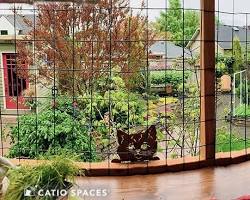
The Purr-fect Perch: Creating a Catio on Your Small Balcony
Creating a Catio for a Small Balcony: A Perfect Outdoor Space for Your Cat
"This post contains affiliate links, which means I may earn a commission if you make a purchase at no extra cost to you.")
A catio is a safe, enclosed outdoor area where cats can enjoy fresh air and sunshine without the risks of free roaming. For city dwellers, especially those with limited space, catios offer a way to bring the outdoors inside a compact living environment. Small balconies in apartments and condos are turning into ideal spots for these mini outdoor sanctuaries. They give cats a chance to explore nature, stretch their legs, and stay mentally and physically active while keeping them safe from traffic, predators, or getting lost.
Building a catio on a small balcony has become popular as more pet owners look for ways to enrich their cats' lives without a yard. It’s a smart solution when space is tight, but the desire to give pets fresh air and sunshine is strong. This guide walks you through planning, designing, and maintaining a catio tailored for a small balcony.
Planning and Designing a Catio for Your Small Balcony
Before you start building, think through the details to make the best use of your balcony’s space. Measuring the area carefully and understanding your balcony’s layout and structure set the foundation for a safe, comfortable catio. Plan a design that balances your cat’s needs with space restrictions, making sure the balcony doesn’t feel cramped. A well-thought-out plan helps avoid costly mistakes and creates a cozy outdoor spot where your cat will love spending time.
Assessing Balcony Safety and Restrictions
Check any building, condo association, or landlord rules about balcony use and modifications first. Some places have strict limits on what can be added or attached to balconies. You’ll need to know the balcony’s weight limits too, especially if you want to add shelves, platforms, or heavy materials. Safety is key — ensure the catio protects your cat from falls by using secure screens or mesh and that it can withstand weather elements. A little research upfront prevents headaches later.
Choosing the Right Materials and Structure
Choose lightweight, weather-resistant materials to keep your catio sturdy but not too heavy for the balcony. PVC pipes, metal mesh, and treated wood often work well. Mesh should be fine enough to keep cats from squeezing through but still allow airflow. Opt for a modular design so you can adjust or move parts easily. Vertical structures help maximize space with climbing shelves and ramps without taking up the floor area. The design should be focused on safety, durability, and space efficiency.
Essential Features and Accessories for a Functional Balcony Catio
A successful balcony catio is more than just an enclosure. It needs to be an inviting and stimulating environment for your cat. Key features include climbing and resting options, weather protection, and enrichment elements that keep your cat entertained and comfortable.
Multi-Level Climbing and Resting Spots
Cats love to climb and perch on high spots. If your balcony space is limited, use vertical shelves, ramps, and platforms to create multiple levels. This gives your cat room to explore and rest while saving floor space. Use sturdy materials and non-slip surfaces to make sure these structures are safe. Adding cozy cushions or beds on the platforms gives your cat a warm place to nap while watching the outside world.
Weather Protection and Ventilation
Ensure your cat stays comfortable no matter the weather. Use shade sails, waterproof covers, or partial enclosures to shield from harsh sun, rain, or wind. At the same time, the catio needs plenty of fresh air to prevent overheating or stuffiness. Position covers so they provide shelter but allow airflow. You can also use a small fan or open gaps in mesh areas to keep air moving during hot days.
Enrichment and Safety Accessories
Add toys, scratching posts, and interactive devices to keep your cat mentally stimulated. Hanging toys from shelves or attaching scratching pads to vertical posts encourage play. Secure locks on doors and entry points keep your cat safely enclosed. Monitoring your cat’s behavior helps spot any stress or discomfort early. Keep an eye on how your cat uses the space, making adjustments if needed to enhance their experience.
Maintenance and Best Practices for Balcony Catios
Keeping your catio clean and safe ensures your cat’s outdoor time stays healthy and pleasant. Regular checks and cleanup routines help avoid problems like pests or worn-out structures.
Routine Cleaning and Pest Control
Use pet-safe cleaning solutions to wipe down floors, shelves, and surfaces regularly. Remove shed fur and any litter that may be tracked outside the catio. Prevent insect buildup by trimming plants near the balcony and using natural deterrents; avoid harsh chemicals that might harm your cat. Proper maintenance helps keep the space fresh and inviting.
Monitoring Safety and Cat Wellbeing
Inspections are important. Look for loose screws, tears in mesh, or any damage that might let your cat escape or get hurt. Check that doors, locks, and nets remain secure. Watch your cat’s reactions to the catio: signs of relaxation, playfulness, and curiosity mean it’s working well. Stress signals like hiding or avoiding the space indicate changes may be needed. Keeping the environment safe helps your cat feel confident outdoors.
Conclusion
A small balcony catio can transform a limited outdoor space into a stimulating, safe haven for your cat. With careful planning and smart designs, even tight spots offer enough room for climbing, resting, and fresh air. Tailoring the materials, layout, and features to your balcony and your cat’s needs creates an inviting space that benefits both pets and owners. A well-built catio lets your cat enjoy nature safely, making urban life more enjoyable for everyone involved.
Cat Balcony Enclosure
